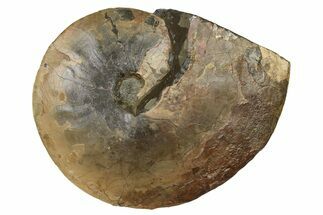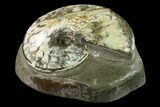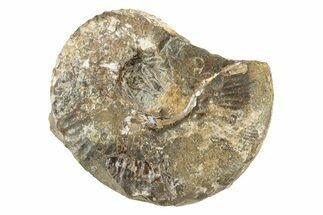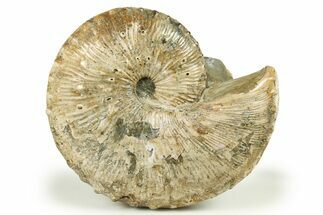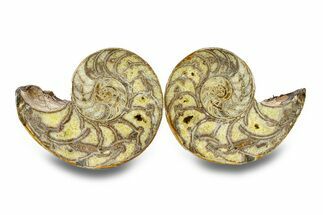This Specimen has been sold.
7.1" Fossil Ammonite (Planticeras) in Rock - South Dakota
This is a large Planticeras meeki ammonite that was collected from the Late Cretaceous age Pierre Shale of South Dakota. Half of it has been prepped free of the hard concretion it was found in. Portions of the shell exhibit gorgeous iridescence.
There is a repaired crack through the ammonite where the rock split during collection. One edge of the specimen is flat, allowing for aesthetic presentation without the need for a display stand.
There is a repaired crack through the ammonite where the rock split during collection. One edge of the specimen is flat, allowing for aesthetic presentation without the need for a display stand.
These 70 million year old ammonites lived when South Dakota was a shallow inland sea. They were found preserved in concretions when split open. They then had to be hand-prepared to remove the hard rock surrounding them from their shells, a very time consuming task.
Ammonites were predatory cephalopod mollusks that resembled squids with spiral shells. They are more closely related to living octopuses, though their shells resemble that of nautilus species. True ammonites appeared in the fossil record about 240 million years ago during the Triassic Period. The last lineages disappeared 65 million years ago at the end of the Cretaceous.
SPECIES
Planticeras meeki
AGE
LOCATION
South Dakota
FORMATION
Pierre Shale
SIZE
7.1" Wide ammonite, entire specimen is 8 x 6.3"
CATEGORY
SUB CATEGORY
ITEM
#143839
We guarantee the authenticity of all of our
specimens. Read more about our
Authenticity Guarantee.
specimens. Read more about our
Authenticity Guarantee.
 Reviews
Reviews

